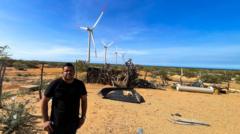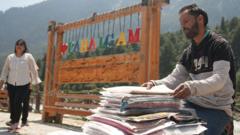**In Churchill, Canada, the polar bears are on land longer than ever due to warming temperatures, raising the stakes for both wildlife and human safety as conservation efforts clash with urgent environmental changes.**
**Polar Bear Coexistence: Churchill's Struggle Amidst Climate Change**

**Polar Bear Coexistence: Churchill's Struggle Amidst Climate Change**
**As polar bears roam closer to the Arctic town of Churchill, residents grapple with the realities of climate change.**
In Churchill, Manitoba, often referred to as the polar bear capital of the world, the relationship between humans and polar bears is being tested like never before. Amidst warming climate changes that are drastically altering the natural environment, residents are faced with an increasing presence of the planet's largest land predators.
During a visit to a local high school, we meet Tee, a spirited 13-year-old who readily shares her safety tips about polar bears. “If there's a bear this close, make a fist and punch it in the nose. It'll just run away,” she advises, demonstrating a distance of about 30 centimeters. While Tee resonates with the local mantra of "bear awareness," her advice exemplifies the reality of living alongside such majestic creatures.
One can hardly ignore the widespread signs scattered throughout the town imploring residents to be vigilant about their surroundings. Here, where the Hudson Bay thaws, polar bears are drawn from the sea ice as they eagerly await the return of frost to access their main food source—seals. Alyssa McCall from Polar Bears International states, "The freeze-up happens here first," making it a crucial period for the bears also relying on dwindling sea ice due to global warming.
Evidence of climate change is palpable as display patterns of polar bear populations suggest a grave decline. Within the Western Hudson Bay area, the population has plummeted from around 1,200 bears in the 1980s to less than half that number today. The connection between this decline and ice-free conditions in the bay is evident; as summer stretches longer, bears spend a month longer on land than their predecessors.
While facing long-term threats, the congregating bears attract crowds of scientists and tourists, eager to glimpse the magnificent wildlife. Our journey ventured into the sub-Arctic tundra with researchers from PBI in tundra buggies, where we experienced a nerve-wracking close encounter with a young bear. "He was using all his senses to investigate us," noted scientist Geoff York, illustrating the fascinating yet risky intersection of human and bear territories.
Technological innovations like radar systems, or "bear-dar," are being tested to improve bear detection and community safety as encounters become increasingly common. Though bear attacks remain rare, they carry undeniable risks, as was evidenced earlier this year by a fatal incident in Nunavut.
Patrolling the community on the front lines, the dedicated polar bear alert team is tasked with keeping residents safe. Ranger Ian Van Nest emphasized the challenges of managing the bears while instilling a deeper understanding of the unique ecological circumstances in which they exist.
Furthering research efforts is the Churchill Marine Observatory, which aims to comprehend environmental change impacts on local ecosystems. This new facility investigates water properties from the Hudson Bay to improve ice forecasts and safeguard the area's marine future.
Reflecting on the intersection of climate change and biodiversity, Churchill’s mayor, Mike Spence, maintains a positive outlook for his town despite the evident dangers posed to the bears. He foresees potential adaptation and growth opportunities on the horizon, marked by increased ship traffic through an extended port season.
As residents like Tee and her classmates gaze across the bay, watching the polar bear alert team's patrols, they ponder a shifting future. “If climate change continues,” muses one student, “the polar bears might just stop coming here.” This poignant statement encapsulates the dual realities of survival and adaptation within a rapidly changing landscape, illustrating the precarious balance between humanity and the Arctic's wild treasures.





















